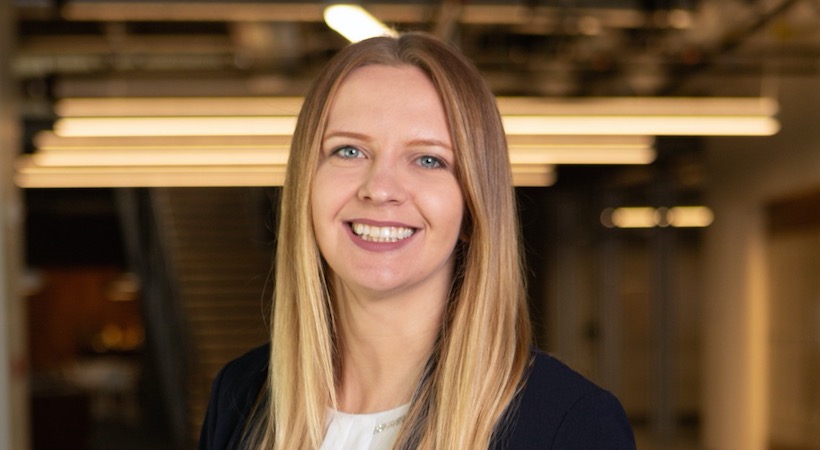After completing my bachelor’s degree in international project engineering in Germany, I moved to the U.S. to start an exciting career as a project management consultant. My responsibility was to help client teams succeed in delivering critical multi-million-dollar construction, manufacturing and event planning projects. I got to fly around the world to develop project plans for the FIFA Soccer World Cup in Russia and worked with teams of engineers on numerous complex manufacturing projects around the U.S.
While I truly loved working in this fast-paced and impactful environment, there was one aspect of the job that I hated more than anything: facilities required employees to wear steel-toe safety shoes when walking on site. The challenge was that I needed to dress professionally around the office and in meetings, but then had to quickly transition into bulky safety boots on the manufacturing floor that didn’t match the rest of my attire.
Unfortunately, when it came to this required footwear, there were no options for women that could look and act the part. At that point, all safety footwear was designed with a masculine look in mind and most companies basically applied the “shrink it and pink it” concept, where they took a man’s boot model and made it smaller with a splash of pink to appeal to women.
$10K Verizon Grants and Other Free Benefits for Entrepreneurs
I knew firsthand that these limited options were the opposite of what professional women wanted. What you wear in the workplace has a major impact on your confidence level and other job-related factors, like performance and promotability. Finally, after years facing this issue along with my female colleagues, I decided to design and manufacture my own safety footwear that I would wear with pride.
The idea for Xena Workwear came from sheer frustration that morphed into an intense drive aimed at solving a serious need: professional women who had been ignored for decades.
Listening with inner confidence
After the initial “aha” moment came the most fragile point that almost killed the whole business idea.
Speaking from experience, I caution every aspiring entrepreneur to take the time to prepare for this seemingly innocent, but highly dangerous step, and that is sharing your idea with the outside world.
I was really excited to share my plans with everyone: family, friends, existing business owners, respected colleagues, other women… however, my enthusiasm was met with highly mixed feedback.
I heard all sorts of pushback: “Women in STEM are unique and don’t care about the way they look,” “You don’t have enough experience in designing shoes or in even running a business,” “The safety footwear industry is impossible to get into with all the restrictions and regulations,” “Your market size is so niche that the sales numbers just aren’t there.”
It took a ton of self-discipline to absorb the constructive feedback, while trusting my instincts in the face of harsh criticism and negativity. Choosing which opinions to trust (and which to block out) was really difficult.
12 Keys to Choosing and Developing a Side Hustle
The big reset and our first steps
In the end, I stood firm and with the help of my husband, we made the decision to start this company together. It was crucial for me (especially this early on) to have a partner in crime who I could trust and who supported my vision through all the turbulence.
As a first step, we went on an extended four-week vacation to Cambodia, Laos and Thailand. We knew that starting and growing a startup would be daunting and that our passion for travel would have to be put on hold. This was a much-needed reset button that helped us prepare for the long journey ahead.
Back in the states, I quit my job and dove deep into the research phase. It took about three to four months to learn everything there is to know about the official U.S. footwear safety standards and to put the first 3D design on paper.
Two more months were then needed to find the right manufacturing partner. My advice is to take your time with this selection. Some countries tried to lure us with heavy discounts and lofty promises, so it was crucial to understand who can be trusted to execute our long-term vision in a reasonable timeframe with streamlined communication. I ended-up selecting a wonderful manufacturing partner in Mexico.
The long process to get it right
I was beyond excited to finally take our initial 3D designs to the prototyping phase. However, I wasn’t quite prepared for how long it would take.
The challenge was that our products had to follow strict safety and testing guidelines that made prototyping much more difficult. All in all, it took over a year and five rounds of prototypes to land on a final model that passed all testing, got certified, and was ready for launch.
During this lengthy waiting period, I got lucky by enlisting the help of brand building marketing experts who were my friends. They helped to form the idea into a real brand with a name and communications guide. It took multiple rounds of finessing and consumer research to finalize the company name, logo, colors, type, tone, style, etc.
Around the same time, we applied got accepted to the gBETA accelerator program, which helped us to develop a business plan, investor pitch and our initial launch strategy for Xena Workwear.

The moment of truth: Customer validation
When building a business, you definitely visualize success, but you don’t truly know how things will turn out until receiving those very first sales and initial comments.
We received dozens of orders on the very first day of launch and best of all, the feedback from customers was amazing! Women were so incredibly happy to finally see a product that was made specifically for them by someone who walked in their shoes (literally!) and understood their frustration.
One important decision that we made was to launch small and to not do heavy advertising. I wanted to ensure that Xena Workwear had a chance to mature and stand for something.
Gathering product feedback, first reviews, tightening-up the communication and wowing our customers took priority over the allure of going for immediate sales. I had no doubt in my mind that building this sound foundation would lead to greater long-term success.
Sign Up: Receive the StartupNation newsletter!
Time just keeps accelerating
I thought time moved faster when I began working on the business, but I didn’t realize that it would go into hyperdrive after we launched.
Just a few months after we went live, we closed our seed funding round of $750,000, which allowed my husband to finally quit his job. It also allowed us to make a key hire in our now full-time CMO, a brilliant strategist who has advised us through every step of the way. We then hired a talented part-time social media manager, writer, photographer and designer.
Ideas began flowing at a blistering pace and we had to learn to adjust our communication styles to suit the needs of our team, which was now spread between Milwaukee and Detroit.
There are countless daily tasks that need to be done when running a business, and I had to learn quickly how to delegate, how to focus my time, and how it’s important to celebrate all that we’ve accomplished to date with the business.
I’d be lying if I didn’t admit to silently enjoying proving the naysayers wrong. Turns out that women in demanding careers do have a desire to look professional. You also don’t need to have a Ph.D. to start a successful business.
Today, I am so humbled by the heights Xena Workwear has already reached, and can’t wait to channel my energy into bringing our ambitious vision for the brand to life in 2020.






